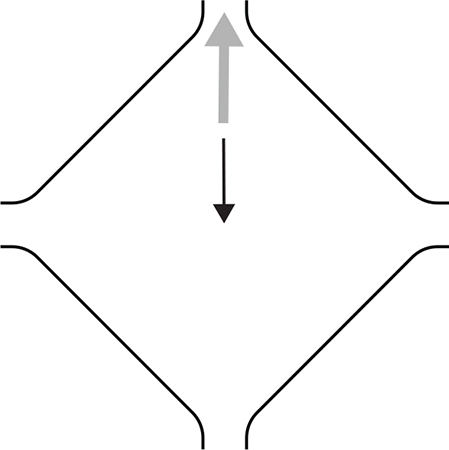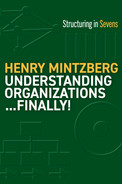CHAPTER 17
In Praise of the Anchored Form
I have some bad news for you. Not only do none of the seven forms of organizations exist in the real world, but they should not exist. The forms don’t exist because, as noted earlier, they are just words and diagrams on paper or screen—depictions of reality, not reality itself. And they should not exist because every organization is replete with nuances, complexities, and contradictions that cannot be ignored. But please don’t put down this book quite yet. I will explain.
Figure 17.1 repeats the diamond diagram again, this time with all but one of the forces removed. With no countervailing force, the remaining one can propel the organization into outer space, so to speak—out of control. A Programmed Machine can become so efficient that it drives everyone crazy, customers and workers alike, just as a Professional Assembly can become so proficient that it fails for want of efficiency. (In a hospital, soiled sheets can be as deadly as sloppy surgery.) In their purest versions, therefore, all the forms are flawed.

FIGURE 17.1 A Form Dominated by a Force
Here, then, we sing the praises of imperfection. Because every form contains the seeds of its own destruction, an anchored version of the form, where some other force holds the dominant one in check, is better than the pure version. Sure, many organizations come rather close to matching one of the forms, but to be effective, that had better not be too close. Hence, rather than throwing the forms out for lack of perfection, we just need to make sure that we understand their limitations.
We describe below a study that has illustrated how each of the four forms, dominated by one force, goes out of control. Then we discuss why this happens: because the dominating force contaminates the organization, hindering the use of other necessary forces. And this brings us to the blessings of containment—of the dominant force by one or more countervailing forces.
The Perils of Excellence
In his book The Icarus Paradox, author Danny Miller described four trajectories that take successful companies out of control—the perils of excellence, if you like.119 They match our four forms rather well.
• About the Personal Enterprise. “The venturing trajectory converts growth-driven, entrepreneurial Builders, companies managed by imaginative leaders and creative planning and financial staffs, into impulsive, greedy Imperialists, who severely overtax their resources by expanding helter-skelter into businesses they know nothing about it.”
• About the Programmed Machine. “The decoupling trajectory transforms Salesmen, organizations with unparalleled marketing skills, prominent brand names, and broad markets, into aimless, bureaucratic Drifters, whose sales fetish obscures design issues, and who produce a stale and disjointed line of ‘me-too’ offerings.”
• About the Professional Assembly. “The focusing trajectory takes punctilious, quality-driven Craftsmen, organizations with masterful engineers and airtight operations, and turns them into rigidly controlled, detail-obsessed Tinkerers, firms whose insular technocratic cultures alienate customers with perfect but irrelevant offerings.”
• About the Project Pioneer. “The inventing trajectory takes Pioneers with unexcelled R&D departments, flexible think-tank operations, and state-of-the-art products, and transforms them into utopian Escapists, run by cults of chaos-living scientists who squander resources in the pursuit of hopelessly grandiose and futuristic inventions.”120
In another book, The Neurotic Organization, Miller and Manfred Kets de Vries suggest how each of our forms likely gets ill: the personal organization becomes dramatic, the machine organization becomes compulsive, the professional organization becomes paranoid, and the project organization becomes schizoid (plus the Divisional Form becomes depressive).121
The Dangers of Contamination and the Blessings of Containment
The advantages of a form are harmony and consistency as well as fit with its situation: each is a culture in its own right. The structure and processes are clear to the players, and so they can get on with their work.
But what if some necessary part doesn’t quite fit—say, a research lab that has to create new products in a Programmed Machine? Then contamination can set in: the other parts try to make it conform. Misfit is the debilitating weakness of the pure form: its dominant force tends to drive out other forces as somehow incorrect. It’s as tough to be a bureaucratic unit in an adhocracy as an adhocratic unit in a bureaucracy.
Okay, so to get around this, a Programmed Machine locates its research lab in the countryside, in the belief that the distance will shield it from the headquarters controls. Well, lead may block radiation, but what can block a determined technocrat? The controller drops in to have a look. It’s 9:00 a.m. “Where is everybody? Can’t these hotshots start at 8:30, like everybody else in this company?” (They left last night at 2:00 a.m., after struggling with some new software.)
Of course, the argument could be made that contamination is the price an organization has to pay for achieving consistency. After all, no organization can be all things to all people. Better to concentrate for clarity than to diffuse and confuse. Sure, but only with containment. Because contamination by one force can sow the seeds of the destruction of a pure form, one or more other forces must contain that force—anchor it in place (Figure 17.2).
While any of the other forces could do this, one may be most appropriate to contain each of the four forms. In both the Personal Enterprise and the Project Pioneer, efficiency may work best to contain an excess of personal power or unbridled creativity. Nothing like a few technocrats to rein both in. In both the Programmed Machine and the Professional Assembly, as well as the Divisional Form and Community Ship, whose programs, protocols, targets, or beliefs can get too tight, collaboration for the sake of adaptation may have to serve as the countervailing force. Nothing like a creative team or two to open things up.

FIGURE 17.2 A Form Contained by a Force
Culture and conflict can also serve as countervailing forces. In a hospital, a compelling culture can encourage physicians to collaborate, while in an entrepreneurial firm, a whistleblower might be able to limit the excesses of the chief. So, to make best use of the diamond framework, please see past the nodes in the corners, to the forces that lurk inside.
